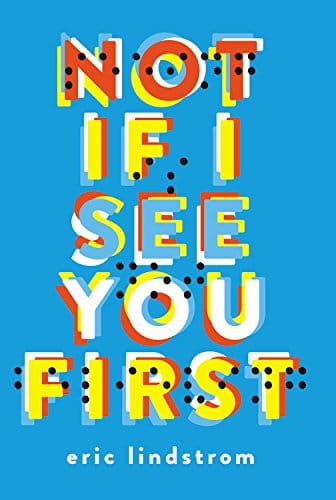Exploring "Not If I See You First": A Bold YA Novel About Blindness, Grief, and Courage
A spoiler-free deep dive into Eric Lindstrom’s YA novel Not If I See You First, covering plot, themes, disability representation and why the story resonates.

Introduction
Not If I See You First by Eric Lindstrom burst onto the young‐adult scene with a heroine unlike any other. Parker Grant is witty, fiercely independent, and blind. In a market crowded with dystopian battles and supernatural romances, Lindstrom’s contemporary novel stands out for its sharp humor, raw honesty, and authentic disability representation. This article offers an in-depth, spoiler-free exploration of the book’s plot, themes, characters, and cultural impact, helping you decide whether it deserves a spot on your reading list.
Quick Synopsis
The story opens three months after Parker’s father dies suddenly, leaving her to navigate junior year with her aunt, uncle, and their children in the family home. Still reeling from grief, Parker keeps herself anchored through running, strict personal rules, and a no-nonsense attitude toward anyone who underestimates her blindness. When Scott Kilpatrick, the boy who broke those rules and her heart in eighth grade, reenters her life, Parker must confront unfinished emotional business while balancing friendship dramas, track team ambitions, and the ever-present ache of loss. The novel unfolds over the course of a single, tumultuous semester, blending laugh-out-loud banter with moments that cut straight to the bone.
Parker Grant: A Protagonist Who Breaks the Mold
Parker is not the saintly “disabled inspiration” trope readers might expect. She cracks jokes about sighted people’s awkwardness, refuses special treatment, and calls out hypocrisy with surgical precision. Her famous Grant Rules—posted on brightly labeled index cards—make her boundaries crystal clear. Rule number one, “Don’t deceive me,” becomes both her shield and her Achilles’ heel as the plot develops. By giving Parker flaws, Lindstrom avoids turning her blindness into a gimmick; instead, it is one dimension of a layered, refreshingly imperfect teenager.
Authentic Representation of Blindness
One of the book’s greatest strengths is its meticulous, research-driven depiction of living without sight. Lindstrom consulted orientation and mobility specialists, blind athletes, and educators to capture realistic details—from voice-labeled clothing tags to running with a tethered guide. The prose often filters the world through Parker’s remaining senses: echoing hallways, whiffs of cafeteria pizza, the vibration of a friend’s laughter. Readers gain insight into adaptive techniques without feeling they are reading a textbook. This authenticity has garnered praise from the blind community and educators seeking inclusive curriculum choices.
Major Themes: Grief, Trust, and Self-Advocacy
Grief permeates every page, yet the novel never descends into bleakness. Parker’s sardonic humor masks her vulnerability, illustrating how teenagers often wield sarcasm as armor. Trust, meanwhile, is explored in complex layers: Can Parker rely on new friends to guide her at a track meet? Can she forgive Scott’s past betrayal? Most compelling is the theme of self-advocacy—Parker’s insistence on making her own decisions, even when adults disagree. Whether she is lobbying to run unaccompanied in gym class or challenging her guidance counselor, Parker’s agency models empowerment for young readers navigating any challenge, disability-related or not.
Supporting Characters Worth Rooting For
Strong ensemble casts elevate YA fiction, and Not If I See You First delivers. Best friends Sarah and Faith provide comic relief and heartfelt loyalty while resisting the “sidekick” stereotype; their own aspirations matter. Cousin Sheila’s well-meaning meddling adds domestic tension, and newcomer D.B. infuses the narrative with unexpected warmth. Each character forces Parker to question her assumptions, illustrating how communities adapt when one member’s needs shift. Lindstrom’s snappy dialogue ensures that even minor figures feel three-dimensional, keeping readers invested until the final page.
Writing Style and Pacing
Lindstrom’s prose is conversational yet precise. Short, punchy sentences mimic Parker’s quick wit, while sensory descriptions slow the action at pivotal moments, heightening emotional resonance. The semester-long timeline supplies natural momentum: homecoming, Thanksgiving, track tryouts, winter break. Chapters often end with cliff-hangery one-liners that beg for “just one more page,” making the 300-plus pages fly by. For reluctant readers, the high stakes and fast pacing serve as an accessible gateway to longer contemporary fiction.
Cultural Impact and Critical Reception
Upon release, the novel earned starred reviews in School Library Journal and Publishers Weekly, and it quickly became a favorite on BookTok and Goodreads lists celebrating disability visibility. Educators incorporate it into units on empathy, while disability advocates cite Parker as proof that mainstream publishing can handle nuanced blind protagonists. The book’s success paved the way for more inclusive YA titles, indicative of a broader industry shift toward authentic voice and representation.
Why You Should Read It
If you love contemporaries that balance laughter with hard truths, Not If I See You First is for you. Fans of John Green’s sharp humor, Nicola Yoon’s emotional stakes, or Rainbow Rowell’s memorable dialogue will find similar satisfaction here. The novel also serves parents and teachers seeking stories that normalize disability without sugar-coating reality. Above all, it offers a universal reminder: courage is not the absence of fear, but the choice to move forward in spite of it.
Tips for Readers New to Disability Narratives
Approach Parker’s story with an open mind, resisting the urge to label her choices as “right” or “wrong.” Remember that no single book can speak for all blind experiences. After finishing, explore #OwnVoices titles by blind authors, such as The Dark Days Club by Alison Goodman, to deepen your perspective. Finally, discuss the novel with friends—representation becomes most powerful when it sparks conversation.
Conclusion
Not If I See You First succeeds as both an entertaining YA romance-friendship drama and a thoughtful exploration of disability, grief, and resilience. Eric Lindstrom gifts readers a protagonist whose blindness is integral yet never defining, framing her struggles and triumphs in universally relatable terms. Whether you pick it up for Parker’s razor-sharp wit, the heartfelt relationships, or the meaningful representation, you are likely to close the book seeing the world just a little differently—no pun intended.



